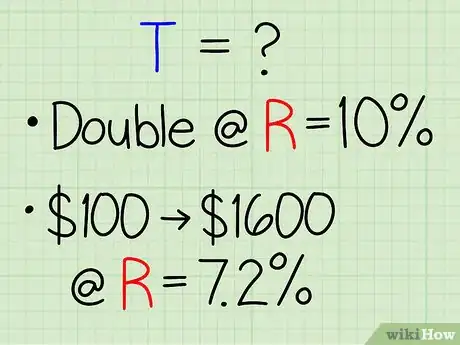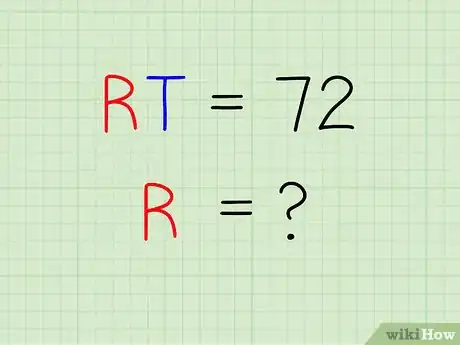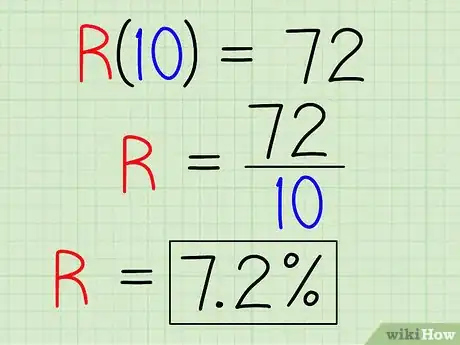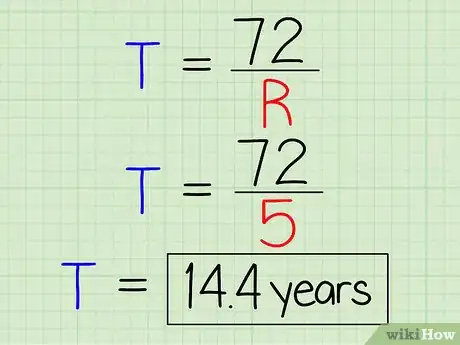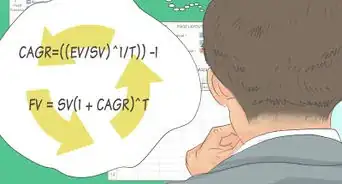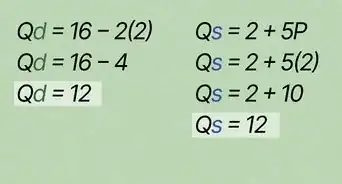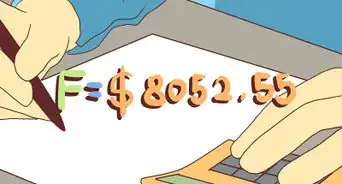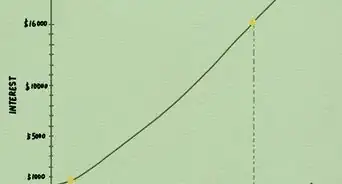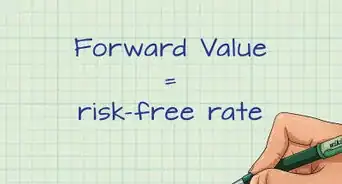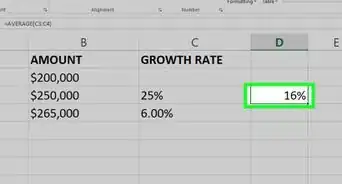wikiHow is a “wiki,” similar to Wikipedia, which means that many of our articles are co-written by multiple authors. To create this article, 25 people, some anonymous, worked to edit and improve it over time.
This article has been viewed 369,345 times.
Learn more...
The Rule of 72 is a handy tool used in finance to estimate the number of years it would take to double a sum of money through interest payments, given a particular interest rate. The rule can also estimate the annual interest rate required to double a sum of money in a specified number of years. The rule states that the interest rate multiplied by the time period required to double an amount of money is approximately equal to 72.
The Rule of 72 is applicable in cases of exponential growth, (as in compound interest) or in exponential "decay," as in the loss of purchasing power caused by monetary inflation.
Steps
Estimating "Doubling" Time
-
1Let R x T = 72. R is the rate of growth (the annual interest rate), and T is the time (in years) it takes for the amount of money to double.[1]
-
2Insert a value for R. For example, how long does it take to turn $100 into $200 at a yearly interest rate of 5%? Letting R = 5, we get 5 x T = 72.[2]Advertisement
-
3Solve for the unknown variable. In this example, divide both sides of the above equation by R (that is, 5) to get T = 72 ÷ 5 = 14.4. So it takes 14.4 years for $100 to double at an interest rate of 5% per annum. (The initial amount of money doesn't matter. It will take the same amount of time to double no matter what the beginning amount is.)
-
4Study these additional examples:
- How long does it take to double an amount of money at a rate of 10% per annum? 10 x T = 72. Divide both sides of the equation by 10, so that T = 7.2 years.
- How long does it take to turn $100 into $1600 at a rate of 7.2% per annum? Recognize that 100 must double four times to reach 1600 ($100 → $200, $200 → $400, $400 → $800, $800 → $1600). For each doubling, 7.2 x T = 72, so T = 10. So, as each doubling takes ten years, the total time required (to change $100 into $1,600) is 40 years.
Estimating the Growth Rate
-
1Let R x T = 72. R is the rate of growth (the interest rate), and T is the time (in years) it takes to double any amount of money.[3]
-
2Enter the value of T. For example, let's say you want to double your money in ten years. What interest rate would you need in order to do that? Enter 10 for T in the equation. R x 10 = 72.[4]
-
3Solve for R. Divide both sides by 10 to get R = 72 ÷ 10 = 7.2. So you will need an annual interest rate of 7.2% in order to double your money in ten years.
Estimating Exponential "Decay" (Loss)
-
1Estimate the time it would take to lose half of your money (or its purchasing power in the wake of inflation). Let T = 72 ÷ R. This is the same equation as above, just slightly rearranged. Now enter a value for R. An example:[5]
- How long will it take for $100 to assume the purchasing power of $50, given an inflation rate of 5% per year?
- Let 5 x T = 72, so that T = 72 ÷ 5 = 14.4. That's how many years it would take for money to lose half its buying power in a period of 5% inflation. (If the inflation rate were to change from year to year, you would have to use the average inflation rate that existed over the full time period.)
- How long will it take for $100 to assume the purchasing power of $50, given an inflation rate of 5% per year?
-
2Estimate the rate of decay (R) over a given time span: R = 72 ÷ T. Enter a value for T, and solve for R. For example:[6]
- If the buying power of $100 becomes $50 in ten years, what is the inflation rate during that time?
- R x 10 = 72, where T = 10. Then R = 72 ÷ 10 = 7.2%.
- If the buying power of $100 becomes $50 in ten years, what is the inflation rate during that time?
-
3Ignore any unusual data. If you can detect a general trend, don't worry about temporary numbers that are wildly out of range. Drop them from consideration.
Doubling Time Chart
Derivation
-
1Understand how the derivation works for periodic compounding.[7]
- For periodic compounding, FV = PV (1 + r)^T, where FV = future value, PV = present value, r = growth rate, T = time.
- If money has doubled, FV = 2*PV, so 2PV = PV (1 + r)^T, or 2 = (1 + r)^T, assuming the present value is not zero.
- Solve for T by taking the natural logs on both sides, and rearranging, to get T = ln(2) / ln(1 + r).
- The Taylor series for ln(1 + r) around 0 is r - r2/2 + r3/3 - ... For low values of r, the contributions from the higher power terms are small, and the expression approximates r, so that t = ln(2) / r.
- Note that ln(2) ~ 0.693, so that T ~ 0.693 / r (or T = 69.3 / R, expressing the interest rate as a percentage R from 0-100%), which is the rule of 69.3. Other numbers such as 69, 70, and 72 are used for easier calculations.
-
2Understand how the derivation works for continuous compounding. For periodic compounding with multiple compounding per year, the future value is given by FV = PV (1 + r/n)^nT, where FV = future value, PV = present value, r = growth rate, T = time, and n = number of compounding periods per year. For continuous compounding, n approaches infinity. Using the definition of e = lim (1 + 1/n)^n as n approaches infinity, the expression becomes FV = PV e^(rT).[8]
- If money has doubled, FV = 2*PV, so 2PV = PV e^(rT), or 2 = e^(rT), assuming the present value is not zero.
- Solve for T by taking natural logs on both sides, and rearranging, to get T = ln(2)/r = 69.3/R (where R = 100r to express the growth rate as a percentage). This is the rule of 69.3.
- For continuous compounding, 69.3 (or approximately 69) gives more accurate results, since ln(2) is approximately 69.3%, and R * T = ln(2), where R = growth (or decay) rate, T = the doubling (or halving) time, and ln(2) is the natural log of 2. 70 may also be used as an approximation for continuous or daily (which is close to continuous) compounding, for ease of calculation. These variations are known as rule of 69.3, rule of 69, or rule of 70.
- A similar accuracy adjustment for the rule of 69.3 is used for high rates with daily compounding: T = (69.3 + R/3) / R.
- The Eckart-McHale second order rule, or E-M rule, gives a multiplicative correction to the Rule of 69.3 or 70 (but not 72), for better accuracy for higher interest rate ranges. To compute the E-M approximation, multiply the Rule of 69.3 (or 70) result by 200/(200-R), i.e., T = (69.3/R) * (200/(200-R)). For example, if the interest rate is 18%, the Rule of 69.3 says t = 3.85 years. The E-M Rule multiplies this by 200/(200-18), giving a doubling time of 4.23 years, which better approximates the actual doubling time 4.19 years at this rate.
- The third-order Padé approximant gives even better approximation, using the correction factor (600 + 4R) / (600 + R), i.e., T = (69.3/R) * ((600 + 4R) / (600 + R)). If the interest rate is 18%, the third-order Padé approximant gives T = 4.19 years.
- To estimate doubling time for higher rates, adjust 72 by adding 1 for every 3 percentages greater than 8%. That is, T = [72 + (R - 8%)/3] / R. For example, if the interest rate is 32%, the time it takes to double a given amount of money is T = [72 + (32 - 8)/3] / 32 = 2.5 years. Note that 80 is used here instead of 72, which would have given 2.25 years for the doubling time.
- Here is a table giving the number of years it takes to double any given amount of money at various interest rates, and comparing the approximation with various rules:
| Rate | Actual Years |
Rule of 72 |
Rule of 70 |
Rule of 69.3 |
E-M rule |
|---|---|---|---|---|---|
| 0.25% | 277.605 | 288.000 | 280.000 | 277.200 | 277.547 |
| 0.5% | 138.976 | 144.000 | 140.000 | 138.600 | 138.947 |
| 1% | 69.661 | 72.000 | 70.000 | 69.300 | 69.648 |
| 2% | 35.003 | 36.000 | 35.000 | 34.650 | 35.000 |
| 3% | 23.450 | 24.000 | 23.333 | 23.100 | 23.452 |
| 4% | 17.673 | 18.000 | 17.500 | 17.325 | 17.679 |
| 5% | 14.207 | 14.400 | 14.000 | 13.860 | 14.215 |
| 6% | 11.896 | 12.000 | 11.667 | 11.550 | 11.907 |
| 7% | 10.245 | 10.286 | 10.000 | 9.900 | 10.259 |
| 8% | 9.006 | 9.000 | 8.750 | 8.663 | 9.023 |
| 9% | 8.043 | 8.000 | 7.778 | 7.700 | 8.062 |
| 10% | 7.273 | 7.200 | 7.000 | 6.930 | 7.295 |
| 11% | 6.642 | 6.545 | 6.364 | 6.300 | 6.667 |
| 12% | 6.116 | 6.000 | 5.833 | 5.775 | 6.144 |
| 15% | 4.959 | 4.800 | 4.667 | 4.620 | 4.995 |
| 18% | 4.188 | 4.000 | 3.889 | 3.850 | 4.231 |
| 20% | 3.802 | 3.600 | 3.500 | 3.465 | 3.850 |
| 25% | 3.106 | 2.880 | 2.800 | 2.772 | 3.168 |
| 30% | 2.642 | 2.400 | 2.333 | 2.310 | 2.718 |
| 40% | 2.060 | 1.800 | 1.750 | 1.733 | 2.166 |
| 50% | 1.710 | 1.440 | 1.400 | 1.386 | 1.848 |
| 60% | 1.475 | 1.200 | 1.167 | 1.155 | 1.650 |
| 70% | 1.306 | 1.029 | 1.000 | 0.990 | 1.523 |
Community Q&A
-
QuestionWhen would I need to use the rule of 72?
 DonaganTop AnswererIt's a handy shortcut when considering compounded, monetary gains or losses. For example, you might want to know how long it would take for invested money to double in value, given a specific rate of interest. See the introduction to the above article.
DonaganTop AnswererIt's a handy shortcut when considering compounded, monetary gains or losses. For example, you might want to know how long it would take for invested money to double in value, given a specific rate of interest. See the introduction to the above article. -
QuestionHow do I calculate compound interest?
 DonaganTop AnswererThe formula for annual compound interest (A) is: P [1 + (r / n)]^(nt), where P=principal amount, r = the annual interest rate as a decimal, n = the number of times the interest is compounded per year, and t = the number of years of the loan or investment.
DonaganTop AnswererThe formula for annual compound interest (A) is: P [1 + (r / n)]^(nt), where P=principal amount, r = the annual interest rate as a decimal, n = the number of times the interest is compounded per year, and t = the number of years of the loan or investment. -
QuestionWhat is APY for an APR of 3.5% compounded?
 DonaganTop AnswererIt depends on how often the interest compounds: annually, semi-annually, quarterly, monthly or daily.
DonaganTop AnswererIt depends on how often the interest compounds: annually, semi-annually, quarterly, monthly or daily.
Warnings
- Let the rule of 72 convince you not to take on high-interest debt (as is typical with credit cards). At an average interest rate of 18%, semiretired credit card debt doubles in just four years (72 ÷ 18 = 4), quadruples in eight years, and becomes completely unmanageable after that.⧼thumbs_response⧽
References
- ↑ http://www.moneychimp.com/features/rule72.htm
- ↑ http://www.moneychimp.com/features/rule72.htm
- ↑ https://betterexplained.com/articles/the-rule-of-72/
- ↑ https://betterexplained.com/articles/the-rule-of-72/
- ↑ https://www.myaccountingcourse.com/financial-ratios/the-rule-of-72
- ↑ https://www.myaccountingcourse.com/financial-ratios/the-rule-of-72
- ↑ https://web.stanford.edu/class/ee204/TheRuleof72.html
- ↑ https://web.stanford.edu/class/ee204/TheRuleof72.html



